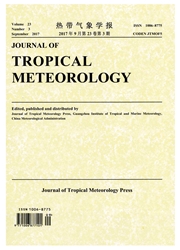

 中文摘要:
中文摘要:
台风 Rananim (0414 ) 被从分析的中心和暴风雨(帽子) 的预言使用非静水力学的先进地区性的预言系统(ARPS ) 模仿了。Rananim 的预言通常用新一代 CINRAD Doppler 雷达数据与 ARPS 被改进了。有那或没有使用数据显示出的雷达的数字实验与在 ARPS 的光线的速度数据能改变的吸收雷达为起始的域建模在对流层的中间和高水平的风域;热带气旋(TC ) 的好特征被介绍进起始的风, TC 的风速度南方的 x 部件被增加那么它向西是 y 部件。他们导致在时间 TC 轨道预报改进在以后乍见陆地。混合混合比率的比率,温度,云水混合比率和雨水的水蒸汽的地被使用雷达反射率数据也改进了。模型对 hydrometeors 的介绍的起始的反应被增加了。水平模型分辨率在紧张预报上有重要影响,这被显示出,由极大地改进特殊预报 TC 的 TC 降雨,和重暴风雨,以及它有时间的分发和变化。
 英文摘要:
英文摘要:
Typhoon Rananim (0414) has been simulated by using the non-hydrostatic Advanced Regional Prediction System (ARPS) from Center of Analysis and Prediction of Storms (CAPS). The prediction of Rananim has generally been improved with ARPS using the new generation CINRAD Doppler radar data. Numerical experiments with or without using the radar data have shown that model initial fields with the assimilated radar radial velocity data in ARPS can change the wind field at the middle and high levels of the troposphere; fine characteristics of the tropical cyclone (TC) are introduced into the initial wind, the x component of wind speed south of the TC is increased and so is the y component west of it. They lead to improved forecasting of TC tracks for the time after landfall. The field of water vapor mixing ratio, temperature, cloud water mixing ratio and rainwater mixing ratio have also been improved by using radar refiectivity data. The model's initial response to the introduction of hydrometeors has been increased. It is shown that horizontal model resolution has a significant impact on intensity forecasts, by greatly improving the forecasting of TC rainfall, and heavy rainstorm of the TC specially, as well as its distribution and variation with time.
 同期刊论文项目
同期刊论文项目
 同项目期刊论文
同项目期刊论文
 期刊信息
期刊信息
